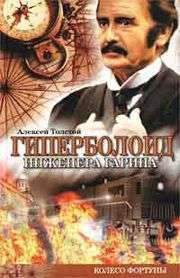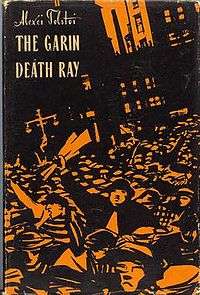The Garin Death Ray
|
Cover of the 1955 English revised edition | |
| Author | Aleksey Tolstoy |
|---|---|
| Original title | Гиперболоид инженера Гарина |
| Translator |
Bernard Guilbert Guerney (1st edition) George Hanna (revised ed.) |
| Country | Soviet Union |
| Language | Russian |
| Genre | Science fiction novel |
| Publisher |
Methuen (1st edition) Foreign Language (revised edition) |
Publication date | 1927 |
Published in English | 1936 (1st edition) and 1955 (revised edition) |
The Garin Death Ray also known as The Death Box and The Hyperboloid of Engineer Garin (Russian: Гиперболоид инженера Гарина) is a science fiction novel by the noted Russian author Aleksey Nikolayevich Tolstoy written in 1926–1927. Vladimir Nabokov considered it Tolstoy's finest fictional work.
The "hyperboloid" in its title is not a geometrical surface but a "death ray"-laser-like device (thought up by the author many decades before lasers were invented) that the protagonist, engineer Garin, used to fight his enemies and try to become a world dictator. "Hyperboloids" of different power capability differ in their effect. The device uses two hyperbolic mirrors to concentrate light rays in a parallel beam. Larger "hyperboloids" can destroy military ships on the horizon, and those of less power can only injure people and cut electric cables on walls of rooms.

Charles H. Townes, the inventor of laser, said that his invention had been inspired by this novel.[1]
The film adaptations of the novel were released in the Soviet Union in 1965 (The Hyperboloid of Engineer Garin) and 1973 (Failure of Engineer Garin).
Estonian band Vennaskond has a song "Insener Garini hüperboloid" (1993) (the hyperboloid of engineer Garin in Estonian).
Russian band Пикник (Piknik) has a song "Гиперболоид" (Hyperboloid) (2008)
References
- ↑ Jacobsen, Annie (2015). The Pentagon's Brain: An Uncensored History of DARPA, America's Top-Secret Military Research Agency. UK: Hachette. pp. 207, 347. ISBN 9780316371650. Retrieved 10 November 2015.
External links
- The Garin Death Ray at the Internet Movie Database, 1965 movie
- Failure of Engineer Garin at the Internet Movie Database, 1973 movie
- Brief movie info page – in Russian, with pictures
- 2006 DVD release – RUSCICO Offers Russian and English subtitles and various features
